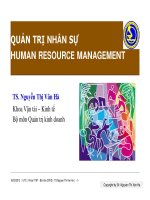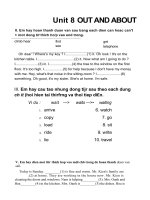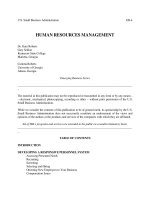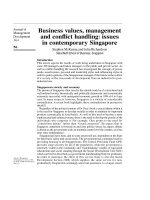Tài liệu Human Resource Management and Army Recruiting - Analyses of Policy Options pdf
Bạn đang xem bản rút gọn của tài liệu. Xem và tải ngay bản đầy đủ của tài liệu tại đây (940 KB, 199 trang )
This document and trademark(s) contained herein are protected by law
as indicated in a notice appearing later in this work. This electronic
representation of RAND intellectual property is provided for non-
commercial use only. Permission is required from RAND to reproduce, or
reuse in another form, any of our research documents.
Limited Electronic Distribution Rights
Visit RAND at www.rand.org
Explore RAND Arroyo Center
View document details
For More Information
This PDF document was made available
from www.rand.org as a public service of
the RAND Corporation.
6
Jump down to document
THE ARTS
CHILD POLICY
CIVIL JUSTICE
EDUCATION
ENERGY AND ENVIRONMENT
HEALTH AND HEALTH CARE
INTERNATIONAL AFFAIRS
NATIONAL SECURITY
POPULATION AND AGING
PUBLIC SAFETY
SCIENCE AND TECHNOLOGY
SUBSTANCE ABUSE
TERRORISM AND
HOMELAND SECURITY
TRANSPORTATION AND
INFRASTRUCTURE
WORKFORCE AND WORKPLACE
The RAND Corporation is a nonprofit
research organization providing
objective analysis and effective
solutions that address the challenges
facing the public and private sectors
around the world.
Purchase this document
Browse Books & Publications
Make a charitable contribution
Support RAND
This product is part of the RAND Corporation monograph series.
RAND monographs present major research findings that address the
challenges facing the public and private sectors. All RAND mono-
graphs undergo rigorous peer review to ensure high standards for
research quality and objectivity.
James N. Dertouzos, Steven Garber
Prepared for the United States Army
Approved for public release; distribution unlimited
Human Resource
Management and
Army Recruiting
Analyses of Policy Options
The RAND Corporation is a nonprofit research organization providing
objective analysis and effective solutions that address the challenges
facing the public and private sectors around the world. RAND’s
publications do not necessarily reflect the opinions of its research clients
and sponsors.
R
®
is a registered trademark.
© Copyright 2006 RAND Corporation
All rights reserved. No part of this book may be reproduced in any
form by any electronic or mechanical means (including photocopying,
recording, or information storage and retrieval) without permission in
writing from RAND.
Published 2006 by the RAND Corporation
1776 Main Street, P.O. Box 2138, Santa Monica, CA 90407-2138
1200 South Hayes Street, Arlington, VA 22202-5050
4570 Fifth Avenue, Suite 600, Pittsburgh, PA 15213-2665
RAND URL: />To order RAND documents or to obtain additional information, contact
Distribution Services: Telephone: (310) 451-7002;
Fax: (310) 451-6915; Email:
Library of Congress Cataloging-in-Publication Data
Dertouzos, James N., 1950–
Human resource management and Army recruiting : analyses of policy options /
James N. Dertouzos, Steven Garber.
p. cm.
“MG-433.”
Includes bibliographical references.
ISBN-13: 978-0-8330-4004-6 (pbk. : alk. paper)
1. United States. Army—Recruiting, enlistment, etc. 2. United States. Army—
Personnel management. I. Garber, Steven, 1950– II. Title.
UB323.D438 2006
355.2'23620973—dc22
2006027016
The research in this report was sponsored by the United States Army
under Contract No. DASW01-01-C-0003.
iii
Preface
is report documents research methods, findings, and policy conclu-
sions from a project analyzing human resource management options
for improving recruiting production. is work will interest those
involved in the day-to-day management of recruiting resources as well
as researchers and analysts engaged in analyses of military enlistment
behavior. is research was sponsored by the Assistant Secretary of the
Army (Manpower and Reserve Affairs) and was conducted in RAND
Arroyo Center’s Manpower and Training Program. RAND Arroyo
Center, part of the RAND Corporation, is a federally funded research
and development center sponsored by the United States Army.
e Project Unique Identification Code (PUIC) for the project
that produced this document is SAMRH02005.
For more information on RAND Arroyo Center, contact the
Director of Operations (telephone 310-393-0411, extension 6419; FAX
310-451-6952; email ), or visit Arroyo’s web
site at />iv Human Resource Management and Army Recruiting
Contents
v
Preface iii
Figures
ix
Tables
xi
Summary
xv
Acknowledgments
xxxiii
Acronyms
xxxv
CHAPTER ONE
Introduction 1
Background
2
Organization of the Report
9
CHAPTER TWO
Determinants of Individual Recruiter Productivity 11
Individual Recruiter Data
11
Regression Results
16
Additional Interpretation of Results
24
CHAPTER THREE
Mission Equity and Determinants of Achieving Station Missions 31
e Station Production Data
34
Logistic Regressions of Making Regular Army Missions
41
Equity of Missions
48
Reserve Missions and Equity
54
Performance Evaluation and Mission Success
54
vi Human Resource Management and Army Recruiting
CHAPTER FOUR
Station Missions, Market Quality, Recruiter Effort, and
Production of High-Quality Contracts
61
Inducing Effort: Lessons from Private-Sector Literature
61
Microeconomic Models of Mission Difficulty, Recruiter Effort,
and Station Productivity
62
Model I: Effort Functions Are Identical Across Stations
64
Model II: Effort Functions Differ Across Stations
69
Econometric Specifications
72
Estimates and Interpretation
76
CHAPTER FIVE
Implications of Alternative Mission Policies for High-Quality
Enlistments
93
Simulated Effects of Alternative Mission Policies
93
Setting Mission in an Uncertain Environment
99
CHAPTER SIX
Career Paths of Recruiters 103
e Enlisted Personnel Dataset
103
Enlisted Personnel Career Paths
107
Implications for Recruiter Selection
112
Rewarding Recruiter Productivity
116
CHAPTER SEVEN
Implications for Effective Recruiter Management 125
Costs and Benefits of Resource Management Policies: Overview
125
Recruiter Selection
126
Recruiter Assignment
128
Setting Missions to Achieve Equity
130
Setting Missions to Increase Production
132
Promotion Prospects and Incentives for Recruiting
136
Identifying and Dealing with Unproductive New Recruiters
138
Conclusion
139
Contents vii
APPENDIX
A. Supplemental Statistical Analyses 141
B. Data Sources
157
References
161
Figures
ix
1.1. Key Elements of the Recruiting “System” 1
3.1. High-Quality Contracts and Missions: Station Monthly
Averages, FY99–FY03
32
3.2. Percentages of Stations Making Mission Box, FY99–FY03
33
4.1. Derivatives of Expected Contracts with Respect to
Goal for ree Levels of the Past Production Ratio
82
4.2. Distribution of Estimated Marginal Products
of Effort (c*)
84
5.1. Explaining High-Quality Enlistments over
Multiple Months
100
Tables
xi
S.1. Predicted Probabilities of Promotion by 2003, Recruiters
Versus Nonrecruiters: 1991 Entering Cohort
xxv
1.1. Organization of U.S. Army Recruiting Command Within
Lower 48 States
3
2.1. Individual Recruiter Data, 1998–2000
12
2.2. Individual Recruiter Production: Linear Regression Results,
1998–2000
17
2.3. Probability Distributions of High-Quality Contracts for
Various High-Quality Mission Levels
20
2.4. Comparative Productivity of African American Recruiters:
Variations by Racial Composition of Local Market
22
2.5. Recruiter Assignments and Home Region
23
2.6. Importance of Groups of Variables in Predicting Individual
Recruiter Production of High-Quality Contracts
25
2.7. Explanatory Power of Alternative Models of High-Quality
Contract Production: Importance of Station- and Recruiter-
Level Effects
26
3.1. Monthly Station-Level Data, January 2001 to June 2003
35
3.2. Logistic Regression Results: Probability of Failing to Make
Regular Army Mission, Holding Mission Constant
42
3.3. Simulations from Logistic Model Holding Missions
Constant
45
3.4. Importance of Subsets of Variables Included in the Logistic
Regression for Predicting Regular Army Mission Success
47
3.5. Logistic Regression Results: Probability of Failing to Make
Regular Army High-Quality Missions, Not Controlling for
ese Missions
49
xii Human Resource Management and Army Recruiting
3.6. Importance of Groups of Variables for Regular Army Mission
Success, Not Holding High-Quality Regular Army Missions
Constant
51
3.7. Top 10 Candidates for Decreasing Missions to Promote
Equity
53
3.8. Top 10 Candidates for Increasing Missions to Promote
Equity
53
3.9. Relationship Between Mission Box Success and Reserve
Recruiting
55
3.10. Frequency of Regular Army Mission Success: Comparison
of Actual and Predicted Rates
56
3.11. Chronic Failure to Make Regular Army Mission as a
Measure of Performance
58
4.1. Nonlinear Least-Squares Regression Analyses of Monthly
High-Quality Contracts at the Station Level, January 2001
through June 2003
77
4.2. Sample Variation in Predicted Contracts and Marginal
Productivity of Effort Due to Groups of Factors
89
5.1. Policy Options for Changing Missions: Simulated Effects
on High-Quality Contracts, January 2001 rough
June 2003
94
5.2. Historical Mission Adjustments Based on Past Performance
99
6.1. Descriptive Statistics for Enlisted Personnel Career
Histories
105
6.2. Data Describing Recruiter Characteristics
106
6.3. Probability Models of Enlisted Personnel Career Paths
108
6.4. Model Simulations: Enlisted Personnel Career Paths
110
6.5. Average Recruiter Effects on Promotion, by Entry Cohort
111
6.6. Probability of Recruiter Tenure
113
6.7. Impact of Past Promotion Speed on Recruiter Tenure
114
6.8. Personnel Attributes: Effects on Recruiter Selection and
Performance
115
6.9. Impact of Recruiter Tenure on Promotion Probabilities,
All Enlisted Personnel
118
6.10. Recruiter Tenure and Predicted Promotion Probabilities
119
6.11. Relative Station Performance and Career Outcomes:
Simulations
121
6.12. Probability of Recruiter Promotion: Effect of Station
Performance
122
Tables xiii
6.13. Station Performance and Promotion Probabilities:
Simulations
123
6.14. Probability of Not Separating, 2001–2003
124
6.15. Predicted Probability of Separation, 2001–2003
124
A.1. Linear Regression Model Used to Impute 1999 Army
Market Share When Actual Share Is Missing
142
A.2. Logistic Regression of Four Ordered High-Quality
Contract Outcomes
144
A.3. Linear Regression Results for Female High-Quality
Recruits as a Percentage of High-Quality Contracts
145
A.4. Linear Regression Results: Station-Level Production of
High-Quality Contracts
147
A.5. Probability of Not Being Promoted to E-6:
Annual Logistic Probability Model Estimate
149
A.6. Probability of Not Being Promoted to E-7:
Annual Logistic Probability Model Estimates
151
A.7. Probability of Not Being Selected for Recruiting:
Annual Logistic Probability Model Estimates
152
A.8. Time Trends in Average Station Performance, 1997–2002
154
A.9. Models of Station Productivity, by Recruiter Cohort
154
A.10. Regression Coefficients of Relative Station Performance in
Determining Career Outcomes
155
B.1. Data Sources
158
B.2. Career Management Fields
159
xv
Summary
e U.S. Army Recruiting Command (USAREC) is charged with pro-
viding the Army with an ongoing flow of qualified volunteers adequate
to meet future active-duty accession requirements. Success is highly
dependent on several factors that USAREC can control and several
others that it cannot control. Among the latter are manpower require-
ments (demand for accessions) as well as supply factors such as market
demographics, alternative labor market and educational opportunities
for youth, and attitudes about military service.
Whatever the prevailing supply and demand conditions, however,
policymakers have several policy levers for increasing the flow of enlist-
ment contracts. Most manpower research has focused on the roles of
recruiting resources such as military pay, enlistment benefits, advertis-
ing programs, and numbers of recruiters. Although such policy instru-
ments have demonstrable expansion effects, they are quite costly to use.
For example, Dertouzos and Garber (2003) provide marginal cost esti-
mates of increasing high-quality enlistments via expansions in military
pay, the recruiting force, and advertising ranging between $13,000 and
$60,000 per additional high-quality recruit.
In contrast, there is little available research on a range of human
resource management policies that are capable of enhancing the pro-
ductivity of the recruiting force. ese policies include personnel selec-
tion and training, recruiter assignment, performance measurement,
and the design of incentive systems that motivate recruiters to be more
productive. More effective policies in these domains could increase
enlistments for little, if any, additional cost.
xvi Human Resource Management and Army Recruiting
is report details research designed to develop new insights to
help guide future recruiter-management policies. e research involves
econometric analyses of three large and rich datasets.
Methods
In Chapter Two, we analyze determinants of the productivity of indi-
vidual regular Army recruiters in enlisting both high- and lower-qual-
ity youth from 1998 to 2000. During this period, recruiters were mis-
sioned and rewarded on an individual basis. e data include monthly
observations for more than 10,000 recruiters and a total of more than
130,000 observations on recruiter-month pairs. is analysis probes
the characteristics of recruiters that are associated with higher and
lower rates of productivity and how productivity relates to matches
between recruiter characteristics and the characteristics of the markets
(station areas) to which they are assigned. e analyses provide insights
relevant to selection of soldiers for assignment to recruiting duty as well
as the types of markets to which recruiters with specific characteristics
might be best assigned.
In Chapter ree, we analyze data for the 30-month period from
January 2001 through June 2003. During this period, all stations were
missioned at the station level and recruiting success was defined in
terms of meeting missions as a team. us, the unit of analysis is a sta-
tion-month, and the dataset includes information for roughly 1,600
stations and a total of more than 42,000 station-month pairs. is
analysis focuses on factors determining the probability that a station
will meet all of its regular Army missions, plus any losses from the
Delayed Entry Program (DEP) charged during the month, in which
case recruiters who wrote at least one contract could be eligible for sta-
tion-level bonus points. (Almost 60 percent of stations also have U.S.
Army Reserve (USAR) missions; these stations must meet both their
regular Army and USAR missions for recruiters to be eligible for sta-
tion-level bonus points.) is analysis also probes the extent to which
allocations of regular Army missions to stations achieves equity across
Summary xvii
recruiters in the sense of equalizing the probabilities of meeting these
missions.
Chapters Four and Five analyze the same data used in Chapter
ree, applying models developed to focus on missioning policies to
promote productivity (efficiency) in regular Army recruiting. In par-
ticular, we estimate models determining the number of high-quality
enlistments by stations on a monthly basis and use the results to simu-
late or predict the effects of alternative missioning policies during the
period covered by the data. e models separately identify the deter-
minants of recruiter effort and the determinants of the quality of a
station’s market area. e key ideas underlying the model are that (a)
contract production depends on the quality of the station’s market
area and the effort level of the recruiters, (b) effort is likely to increase
as missions become more difficult, as long as they aren’t so difficult
that they discourage recruiters and undermine motivation, and (c) in
better markets, less effort is required for recruiters to sign high-quality
youth.
In Chapter Six, we study various relationships between recruit-
ing and the career paths of soldiers. More specifically, we use a dataset
on nearly 90,000 enlisted personnel who entered the Army during the
ten-year period comprising fiscal years 1987 through 1996 to analyze
several outcomes, including which soldiers became recruiters, how long
recruiters stayed in recruiting, and how recruiting duty and productiv-
ity in recruiting affected promotion to the grades of E-6 and E-7 and
the likelihood of remaining in the Army until 2003.
Key Findings
e analysis in Chapter Two relates numbers of high-quality and total
enlistments to market characteristics, traditional supply factors, and
attributes of recruiters. e findings for the period 1998 to 2000, when
missions and award points were assigned on an individual basis, include
the following.
xviii Human Resource Management and Army Recruiting
On average, an increased mission of one high- or low-quality con-
tract resulted in an increase of only 0.12 contracts. In contrast,
estimates reported in Chapter Four imply three times as much
responsiveness during 2001 to 2003, a period when missions were
assigned to stations, missions per recruiter were lower, and the
general recruiting environment may have been better. is sug-
gests that teamwork was effective during the latter period, that
responsiveness to mission is higher when the difficulty of making
mission is lower, or both.
Our estimates enable us to rank groups of factors in terms of their
importance in explaining variations in enlistment outcomes. Mis-
sions and market and demographic factors are most important in
this regard. In decreasing order of importance, other important
factors are nationwide differences in the recruiting environment
over time, measured personal attributes of recruiters, station size,
and region of the country.
Regarding relationships between specific recruiter attributes and
productivity, some of which can be helpful in selecting soldiers for
assignment to USAREC, there are several noteworthy patterns.
First, younger male recruiters with dependents tend to be espe-
cially productive. Second, recruiters whose pre-recruiting mili-
tary occupational specialties (MOSs) are in technical, combat, or
intelligence areas tend to be more productive than those whose
pre-recruiting MOS is in logistics. ird, recruiter Armed Forces
Qualification Test (AFQT) scores and levels of education seem to
have no effect on recruiting productivity.
We also find evidence that unmeasured personal attributes of
recruiters account for more of the variation in production levels
than do the attributes that we were able to measure. Potentially
important unmeasured attributes are soldiers’ talent for selling,
their general levels of motivation and energy, and their time-man-
agement skills.
We also find strong patterns regarding relationships between
recruiter attributes and the characteristics of market areas of the
stations to which they are assigned. Broadly stated, recruiters are
more productive when their characteristics are similar to those of
•
•
•
•
•
Summary xix
many of the youth in their market areas. For example, recruit-
ers assigned to stations in their home states are more productive.
Moreover, African American recruiters are more productive than
other recruiters in areas where African Americans comprise large
proportions of the local population. Female recruiters are more
effective in signing women, although they appear to be less effec-
tive in signing men.
Recruiters in stations with more than one regular Army recruiter
tend to be less productive than those in one-recruiter stations,
and these differences are substantial. For example, stations with
six or more “on-production, regular Army” (OPRA) recruiters are
on average 14 and 17 percent less productive than one-recruiter
stations in enlisting high-quality candidates and all candidates,
respectively. Productivity differences associated with station sizes
might reflect unmeasured factors such as attributes of soldiers
assigned to one-recruiter stations and greater familiarity between
recruiters and members of smaller communities, including high
school counselors, coaches, and other youth influencers. ese
differences may also reflect differences in unmeasured aspects
of attitudes toward the military between larger and smaller
communities.
e analysis in Chapter ree uses data from 2001 to 2003, a
period when missions were assigned on a station-level basis and award
points were available for success as a team, including both regular Army
and USAR recruiters, if any. e focus is on how station-level factors
affected the probability that a station met all three of its regular Army
production goals (i.e., grad alphas, senior alphas, and others
1
) taking
account of substitution rules and DEP losses. Key findings include the
following.
Our estimates regarding the roles of traditional supply factors are
broadly consistent with earlier results.
1
“Alpha” denotes a high-aptitude recruit—an enlistee who scored in categories I through
IIIA on the AFQT. “Grad” and “senior” refer to high school graduates and high school
seniors, respectively.
•
•
xx Human Resource Management and Army Recruiting
Stations met their regular Army goals during one-third of the sta-
tion-months in our sample. If their missions for grad alphas had
been one contract higher, the probability of meeting these mis-
sions would have fallen to about 17 percent; the analogous figure
for adding a senior alpha mission is 20 percent. us, the data
indicate that recruiters have a more difficult time locating and
signing additional grad alphas than senior alphas.
Adding one contract to the mission for “others” (than grad or
senior alphas) lowers the probability of success from the base-
line 33 percent to 28 percent. Comparing this result to those just
reported for additional high-quality missions suggests that high-
quality contracts are about three times as difficult to obtain as
lower-quality ones. Since the ratio of award points for high-qual-
ity contracts to lower-quality contracts is only two to one, this
suggests that recruiters are not being given adequate incentives to
sign high-quality youth, considering the relative costs of produc-
ing the two types of contracts.
Equity in missioning is important in and of itself and because if
recruiters perceive unfairness, it could undermine morale and effort
and thereby reduce productivity. Accordingly, much of the analysis
reported in Chapter ree focuses on the extent to which missions give
stations equal chances of success in meeting their regular Army goals.
Our analysis provides insights about types of factors and specific fac-
tors within each type that are associated with differences across stations
in the probability of succeeding in this sense. Our key findings related
to equity of missioning include the following.
Stations with USAR missions meet their regular Army goals
almost as often as stations without USAR missions (34.6 percent
versus 37.2 percent). But stations with USAR missions succeed
according to the Army’s definition of team success—i.e., meet-
ing all regular Army and USAR missions—much less frequently
than do stations without USAR missions, which in their cases
requires meeting only regular Army missions. In particular, sta-
tions with USAR missions succeed only 16.7 percent of the time
•
•
•
Summary xxi
as compared with 37.2 percent for stations that don’t have USAR
missions.
e most important set of factors accounting for differences in
the probability of success relative to regular Army goals is the
demographics of the stations’ market areas. e following three
sets of factors are each roughly 75 percent as important as demo-
graphics: (a) factors that differ over time but are largely the same
nationwide within months, such as youth attitudes, (b) numbers
of USAR recruiters and the levels of USAR missions, and (c)
supply or market variables (qualified military available (QMA)
2
per OPRA, the level and change in the local unemployment rate,
and the level of civilian wages in the local area).
e analysis also details characteristics of markets associated with
higher and lower probabilities of success in meeting regular Army
missions. ese findings provide guidance about how missions
could be adjusted to promote equity across stations. To promote
equity, missions should be decreased in relative terms for sta-
tions with: (a) relatively high proportions of veterans aged 43 to
54 and 65 to 72 in the state population; (b) large proportions of
Hispanics, African Americans, and children living in poverty in
the local population; and (c) relatively high USAR missions per
OPRA recruiter, holding the number of USAR recruiters con-
stant. Moreover, to equalize probabilities of success over seasons,
missions should be lowered in March and May.
To promote equity, missions should be increased in relative terms
for stations (a) with relatively high proportions of veterans aged
33 to 42 and 56 to 65 in the state population, (b) with more
USAR recruiters per OPRA recruiter, holding the USAR mis-
sions per OPRA constant, (c) in the South and, to a lesser extent,
in the North Central region, and (d) with higher unemployment
rates. Moreover, to equalize probabilities of success over seasons,
missions should be increased in December.
2
QMA counts net out from youth population totals the estimated numbers of youth in
college and those who are ineligible for military service for physical reasons or because of
criminal records.
•
•
•
xxii Human Resource Management and Army Recruiting
We also analyzed the extent to which succeeding relative to regular
Army missions reflects random factors that recruiters cannot control,
an issue that is crucial for assessing station performance. For example,
one might be inclined to observe the number of consecutive months
a station fails to meet its regular Army mission and intervene after a
particular number of months. Our analysis reveals potential pitfalls in
such a procedure. More specifically, we compare the proportion of sta-
tions that would be expected to fail due to chance, given their stations’
missions and the quality of their markets, for a specific number of con-
secutive months with the proportions that actually failed. For example,
among stations that have failed six months in a row, half would be
expected to fail because of pure chance. e analogous proportions for
stations failing 3 and 12 months in a row are 82 and 23 percent.
e analyses reported in Chapters Four and Five develop and
implement new models and methods designed to decompose produc-
tion of high-quality contracts into its two major underlying determi-
nants, namely, the quality of the station’s market area and the effort
levels expended by the station’s recruiters to sign high-quality youth.
We use the results to simulate the effects of various missioning policies.
e key findings are as follows.
As expected, recruiter effort levels increase at a decreasing rate
as the difficulty of meeting the regular Army high-quality goal
increases from low levels of difficulty. e evidence is overwhelm-
ing, however, that during the sample period, missions were virtu-
ally never difficult enough to discourage recruiters to the extent
that effort was reduced.
A station’s recent high-quality production relative to high-qual-
ity mission is an important determinant of effort levels and the
responsiveness of effort to increases in missions. More specifically,
stations with higher ratios of high-quality enlistments to high-
quality missions over a 12-month period ending three months
before the current month expended considerably more effort, and
their effort levels were considerably more responsive to increases
in missions. We believe that these findings are attributable to
•
•
Summary xxiii
higher morale, confidence, or both among recruiters in stations
that have recently been more successful.
ese results suggest that during January 2001 through June
2003 there were unexploited opportunities to increase high-qual-
ity enlistments in two general ways: (a) reallocating the aggregate
high-quality missions differently over stations and over months,
and (b) increasing aggregate high-quality missions.
Regarding reallocating the actual national-level mission over sta-
tions and months, policy simulations suggest that the potential
improvements were significant but not dramatic. In particu-
lar, a reallocation of only 2 percent of total missions could have
increased total high-quality enlistments by 1.0 percent. An opti-
mal reallocation (involving about a third of all missions) could
have resulted in a 2.7 percent productivity increase.
Regarding increases in the aggregate high-quality mission, our
simulations suggest quite substantial potential gains. For exam-
ple, during the time period studied, increasing the monthly high-
quality mission by one contract for the half of stations that would
be most responsive—which involves a 15.5 percent increase in
aggregate high-quality missions—is predicted to have had the
potential to increase high-quality enlistments by 7.4 percent.
Whether such gains would be possible in the current recruiting
environment is unknown.
Our microeconomic theory underlying the econometric models
implies that there is a conflict between equity—in the form of
equalizing the difficulty of making mission—and efficiency—in
the form of maximizing expected contracts—if and only if effort
functions differ across stations. e strong evidence that effort
functions do differ (according to the degree of recent success)
indicates that there is such a conflict.
Market quality varies considerably, and in intuitively sensible
ways, with variations in dozens of variables representing local eco-
nomic conditions, market demographics, seasonal effects, the size
and age distribution of the veteran population, and the region of
the country.
•
•
•
•
•









